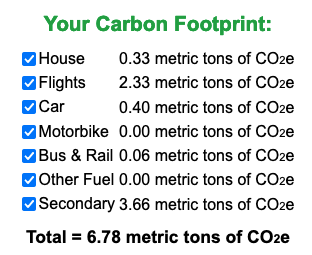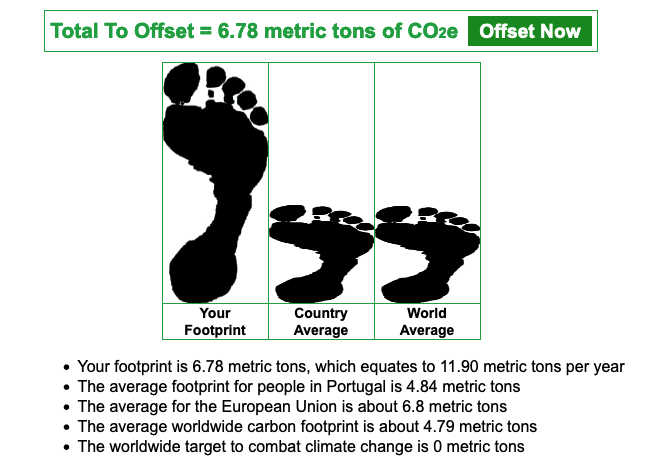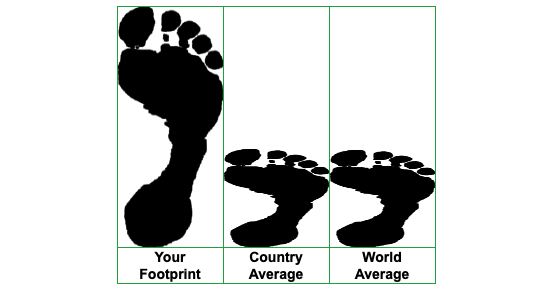Introduction
For the past few weeks, we’ve been thinking a lot about climate change. In the last month we experienced a severe heat wave across Europe that led to major wildfires in France, Spain, and Portugal. The US has also had extreme heat, with several states reporting temperatures above 110º F, and has also seen a significant increase in wildfires. Glaciers are melting in Greenland and Antarctica at the fastest rate in history.
All of this has brought the reality of climate change into sharp relief for us. We’ve been aware of the problem for a long time, but have been somewhat complacent, figuring that since we don’t own a car or a clothes dryer, we were passively doing our part to save the planet. But that no longer seems like enough. In order to get a better handle on it, Mary thought it was time for us to examine our carbon footprint.
What’s a “carbon footprint”?
According to the World Population Review
A carbon footprint is a measure of the total greenhouse gas emissions (primarily carbon dioxide and methane) caused by an individual, community, event, organization, service, product, or nation. A greenhouse gas (GHG) is a gas that absorbs and emits thermal radiation, creating a “greenhouse effect” that traps heat near the Earth’s surface and ultimately warms the planet.
Here’s a 2 minute video that illustrates carbon footprint.
What’s The Goal?
The 2015 Paris Agreement was adopted by 196 countries. It calls for coordinated action to limit global warming to well below 2ºCelsius, preferably to 1.5ºC, compared to pre-industrial levels.
The Intergovernmental Panel on Climate Change (IPCC) is a group of scientists from 195 countries organized by the United Nations to assess the science around climate change and provide governments and policymakers with detailed information to aid in creating climate policies and programs. They have estimated that “human-induced warming” reached 1ºC in 2017 compared to the period 1850 – 1900, and that it is increasing by 0.2ºC every decade.
In 2018, the Columbia University Climate School published a report that clearly stated the goal:
[I]n order to hold the global temperature rise to 2˚C or less, everyone on earth will need to average an annual carbon footprint of 1.87 tons by 2050. Currently, the average U.S. per capita carbon footprint is 18.3 tons. By comparison, China’s per capita carbon emissions are 8.2 tons. We all have a ways to go to get to 1.87 tons.
Calculating Our Carbon Footprint
We wanted to understand our current carbon footprint so we could start taking action to move toward the 1.87 ton goal. Here are the steps we took.
Step 1: Picking a Carbon Calculator
The starting point for this exercise is to select a carbon footprint calculator. There are lots of these online – just Google “carbon footprint calculator” and you’ll find a long list, including sites hosted by the US Environmental Protection Agency and The Nature Conservancy. There are calculators sponsored by companies, like conservation.org, which is “made possible” by the SC Johnson Company, one of many companies who have made a public commitment to reducing carbon emissions
And it wouldn’t be the internet if there wasn’t a list of the “7 Best Carbon Footprint Calculators” . This is a good article by Alex Beale that highlights some of the shortcomings of the various calculators. Some are clearly designed for US or UK audiences. Others make assumptions that may or may not be applicable to you.
It would be easy to get lost in an analysis of the different calculators, trying to figure out which one is most accurate. Mike’s approach was simpler. He was guided by a comment he heard a business colleague make several years ago. When describing a particular financial forecasting effort, Mike’s colleague said, “It’s not precise, but it’s directionally correct”. By that he meant that when used consistently over time, the method would tell us if we were moving in the right direction by showing positive or negative changes. So for us, using the same calculator repeatedly should tell us if we’re making progress toward reducing our carbon footprint.
For our exercise, we chose the calculator at carbonfootprint.com. The site offers calculators for individuals as well as small to medium-sized businesses.
Step 2: Collecting the Data
The carbonfootprint.com calculator uses data from several categories of activity:
- Household energy use. You can enter your usage of electricity, natural gas, heating oil, coal, LPG, propane, and wooden pellets.
- Airplane flights. This is a big one. The European Union estimated that planes emit 285 grams of carbon per kilometer. That’s significantly more than cars (104g / km) or trains (14g/km). We don’t own a car, but we do take a couple of long plane rides every year.
- Other transportation. The site collects your input on distance driven by car or motorcycle and distance traveled on public transportation – bus, train, subway, taxi.
- Other fuel usage. This section captures data on fuel used by boats, lawn mowers, and other powered equipment.
- Secondary usage. This is a broad category that calculates the energy used in the manufacture, distribution, and consumption of consumer goods and services. It asks for the amount you spend on things like food and drink, pharmaceuticals, clothes, computers, furniture, and restaurants. It then estimates the carbon footprint of those activities.
It took us a couple hours to pull together the data needed to complete the calculator. That included time converting electricity and natural gas usage into kilowatt hours as well as making estimates for travel and secondary expenses. Our data is far from precise and includes a number of assumptions and estimates. But since we’re interested in “directionally correct” results, we thought the data would provide a good baseline.
Step 3: Review the Results
Once we entered our information, the site calculated our carbon footprint in metric tons of CO2 emissions. We entered data for a seven month period (January through July, 2022). The calculator computed a result for that period as well as an annualized estimate.
We were surprised by the answer we got – it was higher than we anticipated.


So… Now What?
Now that we have a baseline measurement, we can start to identify specific actions to reduce our carbon footprint. These fall into three broad areas.
Reducing Our CO2 Emissions
We thought we were pretty low emitters, but we also recognize that there’s always more we can do. There are numerous lists published online that provide suggestions. A couple that we’ll use to guide our efforts are:
- “How to reduce my carbon footprint?”, published by the European Union. this is a long list with some very pragmatic actions that anyone could take today.
- “The 35 Easiest Ways to Reduce Your Carbon Footprint”, published by the Columbia University Climate School. This is a shorter list, but it provides explanations of how the actions listed make a difference.
Improving Our Measurements
As we mentioned above, some of our entries in the calculator were estimates based on assumptions. They were sufficient to get us started, but over time we’ll replace estimates with actual numbers. We’re still interested in directionally correct results, but having more accurate data will help us get more precise results in the future.
Investigating Carbon Offsets
While we can continue to reduce our CO2 emissions, it seems unlikely that we would ever get them down to the 1.87 ton target, especially since we plan to continue traveling. So we are investigating carbon offsets – paying money to support projects that reduce greenhouse gases somewhere else. These projects take many different forms. Some involve building solar or wind power installations. Others focus on reforestation – planting thousands of trees to replace ones that have been cut down. We are currently looking for an offset project in Portugal.
This is just the beginning
Now that we know how to measure our carbon footprint, we can take specific steps to reduce it. And while we can’t do everything overnight, we can act with a sense of urgency to do our part to slow the rate of global warming.
We hope this post inspires you to do the same.
Until next week / Até a próxima semana
Mary and Mike
The Cook and The Writer



Fantastic and thought-provoking article. I appreciate it that you took the time to measure your CF and share the results. This would be a wonderful piece to share more broadly.
Many thanks!
Hugs,
Nan
what a great article, I’m going to do this today!
By the way, Jim and I are now living in Valencia. 🙂
Thanks for sharing your experience measuring your carbon footprint and encouraging us to f see o the same.
Great thought provoking article Mike! And you are correct that everyone has an improvement role they can personally play. Hope all is well with you and Mary in Portugal.
Cheers,
Steve